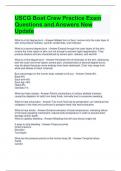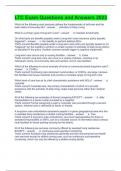USCG Boat Crew Practice Exam
Questions and Answers New
Update
What is a first degree burn - Answer-Mildest form of burn; involve only the outer layer of
skin and produce redness, warmth, tenderness, and mild pain
What is a second degree burn - Answer-Extend through the outer layers of the skin;
involve the inner layers of skin, but not enough to prevent rapid regeneration. They
produce blisters and are characterized by severe pain, redness, and warmth.
What is a third degree burn - Answer-Penetrate the full thickness of the skin, destroying
both the outer and inner layers; severe pain, characteristics of second degree burns,
may be absent because nerve endings have been destroyed. Color may range from
white and lifeless to black (charred)
Burn percentage on the human body needed to kill you - Answer-Chest=8%
Back=8%
Each arm=9%
Each leg=18%
Head=9%
Genitals=1%
What are heat cramps - Answer-Painful contractions of various skeletal muscles;
caused by depletion of salts from body fluids, normally due to excessive sweating.
What is heat exhaustion - Answer-Too much fluid lost by perspiration; an individual that
collapses in the heat and continues to perspire freely has heat exhaustion
What is heat stroke - Answer-Extreme elevation of body temperature, indicating failure
of the body sweating mechanism; reduce body temperature in order to prevent brain
damage and/or death.
What is capillary bleeding - Answer-Bleeding that will ooze blood, bright red
4 ways to stop bleeding - Answer-Pressure points
Direct pressure
Elevation
Tourniquet
What are the pressure points on the human body (9) - Answer-Temporal artery
Facial
Carotid
,Brachial
Radial
Femoral
Popliteal
Posterior tibial
Dorsalis pedis
How do you treat each type of burn - Answer-1st Degree: Immerse in cold water, flush
chemical burns 20 minutes, cover with sterile bandage.
2nd degree: same as first, do not break open blisters, cover sterile dry non adhesive
dressing, for deep 2nd degree burns follow 3rd degree steps.
3rd degree: cover to reduce exposure to air, cool the burn, do not remove clothing
unless smoldering, treat for shock, always obtain medical care, monitor airway, assess
vital signs every 5 minutes, give nothing to eat or drink, do not place ice on the burn, do
not apply ointments to the burn. Burns of the respiratory track are always a medical
emergency.
What are some symptoms of shock (8) - Answer-1) Restlessness
2) Fainting
3) Thirst
4) Nausea
5) Weakness
6) Anxiousness
7) Fright
8) Dizziness
What are the symptoms of heat stroke - Answer-Red skin, hot and dry to the touch,
body temp above 105 F, head ache, weak and rapid pulse, confusion, violence, lack of
coordination, delirium, unconsciousness, brain damage.
What are the symptoms of heat exhaustion - Answer-Person collapses and sweats
profusely, pale skin, a pounding heart, nausea, headache, and acts restless
What are the CPR procedures (8) - Answer-1) Attempt to revive patient using a sternal
rub and shouting "Are you OK?"
2) If no response, recruit someone to call 911, and another to get the AED (if available)
3) Lay the victim on their back if they are not already
4) Look, listen, and feel for chest rise and breathing
5) If patient does not appear to be breathing, start chest compressions at about 2-
inches deep, counting to 30
6) Perform a head-tilt/chin-lift maneuver to open airway and administer 2 artificial
respirations (preferably using a pocket mask or BVM) just long enough to see chest
rise.
, 7) Perform another 30 chest compressions
8) Perform CPR until the patient revives, EMS arrives, or the rescuer is physically
unable to continue
In what situations would you not perform CPR - Answer-When the patient is obviously
dead; decapitation, incineration, major organs are missing, rigor mortis, lividity
Compression depth for adults children and infants in CPR - Answer-2 arms, 1.5 to 2
inches
1 arm, 1/3 to 1/2 chest depth
2 fingers, 1/3 to 1/2 chest depth
How do you treat a person in shock - Answer-CPR, limit patients activity, have person
lie down and remain alert for signs of shock, activate EMS, if no head injury or breathing
problems lay flat on back and elevate lower extremities 8-10 inches, warm with blankets
unless hot, moisten lips if requested, do not allow to drink, never give alcohol, and
handle gently.
P-6 Pump Specs - Answer-250 gallons a minute at a 12 ft suction lift
2.5 gallon detachable tank of gasoline
4-5 hours on a full tank of gas
If gas is cut off it should run for at least 45 seconds.
6.5 HP
3 inch diameter suction
15 ft suction hose
20 ft discharge hose
Yellow hose is suction Green hose is discharge
What are some situations that will cause fatigue (9) - Answer-1.Operating in extreme
temperatures
2. Eye strain from hours of looking through sea blurred windshields
3. Effort of holding on and maintaining balance
4. Stress
5. Exposure to noise
6. Exposure to sun
7. Poor physical conditioning
8. Lack of sleep
9. Boredom
What is the crews responsibility for fatigue - Answer-Crew members must constantly
watch each other for signs of fatigue
Responsibility of a boat crew member ( HALT SOLA) - Answer-Helm





